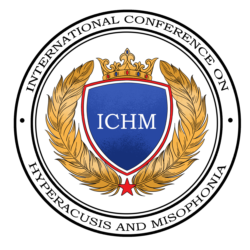
In the UK, audiologists who are specialized in tinnitus rehabilitation play a major role in providing support and therapeutic services to patients who experience hyperacusis (Aazh et al. 2014; Pienkowski et al. 2014; Tyler et al. 2014). Assessment of hyperacusis usually involves pure-tone audiometry, the measurement of uncomfortable loudness levels (ULLs), and self-report questionnaires, typically the Hyperacusis Questionnaire (HQ) (Khalfa et al. 2004). The pure-tone average (PTA) threshold across the frequencies 0.5, 1, 2, and 4 kHz provides a measure of the weakest sounds that can be detected for tones with different frequencies. In contrast, ULLs provide a measure of the sound level above which tones with different frequencies become uncomfortably loud. For normal-hearing people without hyperacusis, the average ULL across the audiometric frequencies is about 100 dB hearing Level (HL) (Sherlock & Formby 2005).
The average ULLs reported for patients with hyperacusis (when diagnosed via measures other than ULLs, such as questionnaires) vary widely across studies, from 66 dB HL (standard deviation, SD =15) (Blaesing & Kroener-Herwig 2012), to 77 dB HL (Anari et al. 1999), and 83 dB HL (SD = 17) (Sheldrake et al. 2015). This makes the diagnosis of hyperacusis based on ULLs difficult. The criteria for diagnosing hyperacusis handicap based on HQ scores are not generally agreed either. Khalfa et al. (2002) suggested a cutoff score of 28 as indicating hyperacusis handicap. Meeus et al. (2010) suggested reducing the cutoff score to 26, while Fackrell et al. (2015) suggested that the cutoff score of 28 needs to be revaluated but did not propose a definitive value.
At ICH3, Brian C. J. Moore (University of Cambridge, UK) and Hashir Aazh (Royal Surrey County Hospital, UK) presented their recent research findings with regard to the diagnosis of hyperacusis. They assessed the criteria for diagnosing hyperacusis based on measurements of ULLs and scores for the HQ for 573 consecutive patients who attended the Tinnitus and Hyperacusis Therapy Specialist Clinic (THTSC) (Aazh & Moore 2017a). Their results showed that a diagnosis of hyperacusis based on HQ scores can be made consistent with a diagnosis based on ULLs if the following cutoff scores are adopted for a positive diagnosis: the average ULL at 0.25, 0.5, 1, 2, 4 and 8 kHz for the ear with the lower average ULL, ULLmin, should be ≤77 dB HL and the HQ score should be ≥22. With these cutoff values, 95% of patients with HQ scores meeting the criterion will also meet the criterion based on ULLs, and vice versa. However, the cutoff values for ULLs and HQ scores proposed by Aazh and Moore (2017a) lead only to a binary decision; hyperacusis is either present or absent. Further work needs to be conducted in developing psychometric instruments to determine the severity of hyperacusis, its subtypes and its impact on a patient’s life.
Dr. Hashir Aazh

At ICH3, Brian Moore and Hashir Aazh also discussed possible problems that can arise during measurement of audiometric thresholds and ULLs when patients have unusually low ULLs. In extreme cases of hyperacusis, ULLs can be as low as 10 dB HL (Aazh & Moore 2018). Such low ULLs raise the possibility that some patients will experience discomfort during routine audiometry and measurement of ULLs. The proportion of patients for whom this might happen was assessed in a recent study by Aazh and Moore (2017b). The study was based on 362 consecutive patients who attended a National Health Service audiology clinic for tinnitus and/or hyperacusis rehabilitation. Pure-tone audiometry was conducted using the procedure recommended by the British Society of Audiology (BSA) (British Society of Audiology 2011) for frequencies of 0.25, 0.5, 1, 2, 3, 4, 6, and 8 kHz. A similar procedure is used in many countries. According to this procedure, once the threshold has been determined at a given frequency, the initial level when assessing the threshold for the next frequency should be “at a clearly audible level (e.g. 30 dB above the adjacent threshold) (p. 11), but never more than 80 dB HL. An experience of discomfort during pure-tone audiometry was deemed to be present when a test tone with a given frequency presented at 30 dB above the threshold for an adjacent frequency exceeded the ULL at the test frequency for at least one of the measured frequencies. Remarkably, the results showed that discomfort would have occurred for 21% of the patients. The incidence of discomfort would have been reduced to 10%, 2.7%, and 0.8% if the starting level had been 20 dB above, 10 dB above, or at the same level as the threshold for the adjacent frequency, respectively.

Professor Brian C.J. Moore
In the study of Aazh and Moore (2017b), ULLs were also measured using the BSA recommended procedure (British Society of Audiology 2011). According to this, the audiologist should “Start testing at 60 dB HL or at the subject’s hearing threshold level for that ear at that frequency, whichever is highest, unless otherwise indicated (Section 2.2) (p.7). An experience of discomfort during measurement of ULLs was deemed to be present if the starting level of 60 dB HL exceeded a patient’s ULL for at least at one of the measured frequencies. Discomfort would have occurred for 24% of the patients using this criterion. The incidence of discomfort would have been reduced to 3.6% if the starting level had been reduced to 30 dB HL and to 0.5% if the starting level had been reduced to 15 dB HL.
Given the high prevalence of anxiety and stress in patients seeking help for tinnitus and hyperacusis (Aazh & Moore 2017c), it is very important to ensure that any evaluation procedures do not lead to unnecessary discomfort. If discomfort is experienced, this might trigger further anxiety and stress, leading to worsening of the symptoms and to possible loss of trust in the audiologist. This in turn might reduce the effectiveness of any therapy performed by the audiologist after the initial evaluation. To avoid discomfort during PTA, Aazh and Moore (2017b) suggested using an initial level of 0 dB HL at the starting frequency of 1 kHz and setting the level for subsequent frequencies to be equal to the level at threshold for the previously tested frequency. To avoid discomfort during measurement of ULLs, they recommended that the starting level for a given test frequency should be equal to the measured audiometric threshold at that test frequency and that levels above 80 dB HL should not be used.
References
Aazh, H., McFerran, D., Salvi, R., et al. (2014).
Insights from the First International Conference on Hyperacusis: causes, evaluation, diagnosis and treatment.
Noise Health, 16, 123-6.
Aazh, H., & Moore, B. C. J. (2017a).
Factors related to Uncomfortable Loudness Levels for patients seen in a tinnitus and hyperacusis clinic.
International Journal of Audiology 56, 793-800.
Aazh, H., & Moore, B. C. J. (2017b).
Incidence of discomfort during pure-tone audiometry and measurement of uncomfortable loudness levels among People seeking help for tinnitus and/or hyperacusis
American Journal of Audiolgy, 26, 226-232.
Aazh, H., & Moore, B. C. J. (2017c).
Usefulness of self-report questionnaires for psychological assessment of patients with tinnitus and hyperacusis and patients’ views of the questionnaires.
International Journal of Audiology, 56, 489-498.
Aazh, H., & Moore, B. C. J. (2018).
Prevalence and characteristics of patients with severe hyperacusis among patients seen in a tinnitus and hyperacusis clinic
Journal of American Academy of Audiology, 29, 626-633.
Anari, M., Axelsson, A., Eliasson, A., et al. (1999).
Hypersensitivity to sound–questionnaire data, audiometry and classification.
Scand Audiol, 28, 219-30.
Blaesing, L., & Kroener-Herwig, B. (2012).
Self-reported and behavioral sound avoidance in tinnitus and hyperacusis subjects, and association with anxiety ratings.
Int J Audiol, 51, 611-7.
British Society of Audiology (2011).
British Society of Audiology Recommended Procedure, Determination of uncomfortable loudness levels.
Reading, UK: British Society of Audiology.
Fackrell, K., Fearnley, C., Hoare, D. J., et al. (2015).
Hyperacusis Questionnaire as a tool for measuring hypersensitivity to sound in a tinnitus research population.
Biomed Res Int, 2015, 290425.
Khalfa, S., Bruneau, N., Roge, B., et al. (2004).
Increased perception of loudness in autism.
Hear Res, 198, 87-92.
Khalfa, S., Dubal, S., Veuillet, E., et al. (2002).
sychometric normalization of a hyperacusis questionnaire.
orhinolaryngol Relat Spec, 64, 436-42.
Meeus, O. M., Spaepen, M., Ridder, D. D., et al. (2010).
orrelation between hyperacusis measurements in daily ENT practice.`
Int J Audiol, 49, 7-13.
Pienkowski, M., Tyler, R. S., Roncancio, E. R., et al. (2014).
A review of hyperacusis and future directions: part II. measurement, mechanisms, and treatment.
Am J Audiol, 23, 420-36.
Sheldrake, J., Diehl, P. U., & Schaette, R. (2015).
Audiometric characteristics of hyperacusis patients.
Front Neurol, 6, 105.
Sherlock, L. P., & Formby, C. (2005).
Estimates of loudness, loudness discomfort, and the auditory dynamic range: normative estimates, comparison of procedures, and test-retest reliability.
Am Acad Audiol, 16, 85-100.
Tyler, R. S., Pienkowski, M., Rojas Roncancio, E., et al. (2014).
A review of hyperacusis and future directions: part I. definitions and manifestations.
American Journal of Audiology, 23, 402-419.

